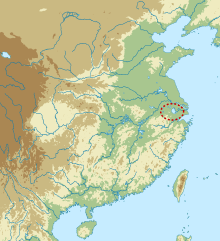Majiabang culture
 | |||||||
| Geographical range | Zhejiang, China | ||||||
|---|---|---|---|---|---|---|---|
| Period | Neolithic China | ||||||
| Dates | 5000–3350 BC | ||||||
| Followed by | Liangzhu culture | ||||||
| Chinese name | |||||||
| Chinese | 馬家浜文化 | ||||||
| |||||||
The Majiabang culture was a Chinese Neolithic culture that existed at the mouth of the Yangtze River, primarily around Lake Tai near Shanghai and north of Hangzhou Bay. The culture spread throughout southern Jiangsu and northern Zhejiang from around 5000 BC to 3300 BC.[1] The later part of the period is now considered a separate cultural phase, referred to as the Songze culture.[2]
Initially, archaeologists had considered the Majiabang sites and sites in northern Jiangsu to be part of the same culture, naming it the Qingliangang culture. Archaeologists later realized that the northern Jiangsu sites were of the Dawenkou culture and renamed the southern Jiangsu sites Majiabang culture. Some scholars state that the Hemudu culture co-existed with the Majiabang culture as two separate and distinct cultures, with cultural transmissions between the two. Other scholars group Hemudu in with Majiabang subtraditions.[3]
Majiabang people cultivated rice. At Caoxieshan and Chuodun, sites of the Majiabang culture, archaeologists excavated paddy fields, indicating the centrality of rice to the economy.[4][5] In addition faunal remains excavated from Majiabang archaeological sites indicated that people had domesticated pigs. However, the remains of sika and roe deer have been found, showing that people were not totally reliant on agricultural production.[6] Archaeological sites also bear evidence that Majiabang people produced jade ornaments.
In the lower stratum of the Songze excavation site in Shanghai's modern day Qingpu District, archaeologists found the prone skeleton of one of the area's earliest inhabitants—a 25-30-year-old male with an almost complete skull dated to the Majiabang era.[7]
References
- ↑ Wang (2001), p. 207.
- ↑ Wang (2001), p. 206.
- ↑ Wang (2001), p. 209.
- ↑ Fujiwara, H. (ed.). Search for the Origin of Rice Cultivation: The Ancient Rice Cultivation in Paddy Fields at the Cao Xie Shan Site in China. Miyazaki: Society for Scientific Studies on Cultural Property, 1996. (In Japanese and Chinese)
- ↑ Fuller, Dorian Q & Qin, Ling (2009) Water management and labour in the origins and dispersal of Asian rice. World Archaeology 41(1): 88-111
- ↑ Tsude, Hiroshi. Yayoi Farmers Reconsidered: New Perspectives on Agricultural Development in East Asia. Bulletin of the Indo-Pacific Prehistory Association 21(5):53-59, 2001.
- ↑ "The Shanghainese of 6000 Years Ago - the Majiabang Culture". Shanghai Qingpu Museum. Retrieved 24 November 2014.
- Wang, Haiming (2001), "Majiabang", in Peregrine, Peter N.; Ember, Martin, Encyclopedia of Prehistory, Volume 3: East Asia and Oceania, Springer, pp. 206–221, ISBN 978-0-306-46257-3.
Further reading
- Chang, Kwang-chih. The Archaeology of Ancient China, ISBN 0-300-03784-8
Coordinates: 30°44′09″N 120°42′54″E / 30.73583°N 120.71500°E